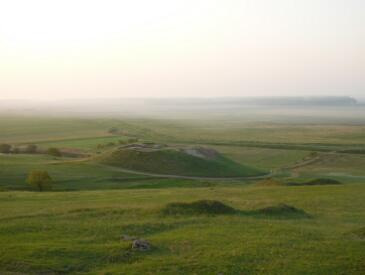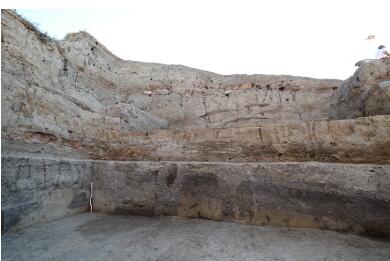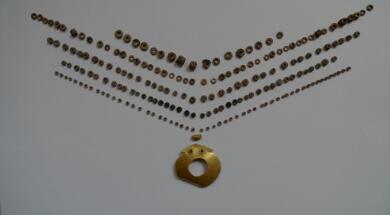2019 SAF Discovery Awards|The Copper Age Settlement Mound 'Măgura Gorgana' near Pietrele on the Lower Danube
The slightly oval-shaped settlement mound Măgura Gorgana near Pietrele in southern Romania, with a massive circumference of ca. 255 m and E-W diameter of nearly 97 m and N-S diameter of 90 m, stood 11.5 m high in its final phase and still looms an impressive 9 m above its surroundings. In its last settlement phase, the imposing hill rose above the Danube valley, visible from afar.
Excavations in Pietrele on the Lower Danube have taken place consistently every summer since 2004 in cooperation with the Eurasia Department of the German Archaeological Institute and the Institute of Archaeology of the Romanian Academy of Sciences as well as the Institute for Physical Geography at the Goethe University of Frankfurt and have been magnanimously supported by the German Research Foundation.
According to our current state of research, life on the settlement mound lasted around 300 years between ca. 4550 and 4250 BCE. During this time period, settlement mounds in most regions of Southeastern Europe had already been abandoned. The mounds in southern Romania are not only unique in their late adaption of this type of settlement, but they differ in form from other Southeastern European settlement mounds, as well. One characteristic element is their height and steep slope, which contribute to their widespread visibility among the surrounding landscape, differing from the flat settlement mounds of the Theiss and Vinča Culture in the southern Carpathian Basin.
In the southern part of the tell, we were able to excavate a complete settlement sequence, providing us with a remarkable stratigraphical sequence measuring 11.5 m – a painstaking achievement that was understandably both technically demanding and time-consuming. The rewarding result, however, is the first complete, documented stratigraphy for the Gumelniţa Culture spanning 300 years, between 4550 and 4250 BCE.
An accumulation of 11.5 m over 300 years is very unusual; for comparison, the famous Karanovo settlement mound in Bulgarian Thrace stands 13 m high, only slightly larger than Pietrele, yet its occupation extends from the Early Neolithic to the Bronze Age. Its Level VI, contemporaneous with Pietrele, is just over 3 m in thickness.

A layer thickness of more than 11 m in Pietrele for the same period thus requires an explanation; we are, perhaps, led away from the idea of the settlement mound as the remnants of settlements and introduce the idea of the mound as monumental architecture. All over the mound, the burnt and destroyed houses were piled up with thick layer packages of material originating from the area surrounding the mound. The radiocarbon dates clearly show continuous, uninterrupted use of the settlement. Furthermore, its houses can be used as “closed contexts”, which will the basis for the description of pottery development that benefits tremendously from an inventory of over 2,500 complete vessels.
The settlement mound grew quickly, as all the burnt and unburnt houses were covered with nearly a meter of clay and sand packages before a new house was built atop them. These massive packages additionally served both to seal off older settlement layers and also to provide the necessary foundation to support a new house, whose new posts were dug into these filling layers. Life on the settlement mound was associated not only with the effort involved in the steep ascent and descent of the tell as well as repeated fires within the settlement and accompanying catastrophes, but also with the instability of the mound itself – threats of landslides and cavitation within the mound increased significantly throughout the duration of the settlement period. One could therefore conclude that the social significance of life upon the tell outweighed the inconveniences.
For a long time, the settlement mound was seen to have served as the entire settlement. One of the most important results of our research was the discovery of a substantially larger settlement at the foot of the mound, namely a flat settlement encompassing 5 ha, the limits of which have not yet been determined by geophysical surveys. Because the flat settlement existed primarily during the later phase of the settlement mound’s occupation, the question arose as to how to interpret the tell itself. One hypothesis suggests that the settlement mound served both as the nucleus of the settlement as well as a representation of social and political governance. This is perhaps best supported by the enormous density of finds and general high quality of the artifacts; for instance, metal objects have almost exclusively been found in the tell.
The beginning of the settlement mound in Pietrele dates back to ca. 4550 BCE or, according to Romanian terminology, the transition period between the Late Neolithic (Boian Culture博伊文化) and the Copper Age (Gumelniţa Culture). The few 14C dates from other settlement mounds in the region put forth a comparable picture that confirms this transition period. It follows that the settlement mound was therefore a component of a comprehensive program of new establishments; we can certainly claim Pietrele to have been a new establishment as opposed to having been borne of an existing Neolithic settlement.
Topography
From the outset, reconstruction of the 5th millennium BCE landscape was crucial to the excavations in Pietrele. Research suggested that, during this time, the Danube flowed through a larger lake, tentatively named “Lacul Gorgana”. This lake stretched approximately from the modern-day city of Giurgiu to the modern-day city of Olteniţa and was likely larger than the Bodensee. The significance of these results is not confined to the local settlement history of Pietrele, but extends much further beyond, as well. The Neolithic and Copper Age settlements sat on the edge of the terrace of the present-day meadow, what was once the former embankment of the paleolake. Pietrele, alongside other Copper Age settlements, therefore enjoyed direct access to the water and the Danube. Settlement mounds like Sultana, that seem today to sit in the “hinterlands”, were likely connected to a system of lakes.
These lakeside-dwellers were doubtless equipped with boats for mobility. The lake presented the residents of Pietrele with a significant food resource, as seen by the scores of fish remains discovered within the settlement, and it also served as an important transit system. In addition, the lakeside location illuminates the close overlapping of material culture among the Gumelniţa period settlements: these lakeside settlements on “Lacul Gorgana” essentially constituted the core of the Gumelniţa Culture, which deviates from the Thracian Karanovo Culture and from the northern Bulgarian Kodžadermen Culture in several ways.
As mentioned above, the lake provided the residents of Pietrele and its neighboring settlements with a rich source of food. The exquisite degree of preservation as well as the massive collection of recovered bones and the results gathered by wet-sieving allow for a methodologically secure basis in treating the magnitude of fishing activities that took place in Pietrele. Fish remains found in the settlement mostly include cyprinids (carp), catfish, bass and pike. Unfortunately, only a very small portion of the fishing tools and materials were preserved; nets and fish traps or wooden fishing devices that would otherwise be preserved in waterlogged settlements have long since deteriorated. But net-fishing must have been practiced frequently in Pietrele, as reflected in the massive amount of smaller fish remains.
Social Archaeology
The Copper Age in Southeastern Europe was a dynamic time period within the development of European culture. The spoils of mining and the smelting of new metal materials not only lent themselves to the naming of a new archaeological epoch, but they also doubtlessly ushered in an onslaught of the most revolutionary changes seen since the dawn of agriculture. Neither modern industry nor the technological developments that begot it would exist without metal. The immediate consequences may have been regionally confined, but they ended up being so pervasive that they had soon led to irreversible developments in many areas. Copper and gold had a particularly strong effect on developments in the Carpathian Basin and in Southeastern Europe.
The magnitude of the potential that metal offered was certainly not fully comprehensible, but the characteristics of this material undoubtedly presented significant conceptual obstacles: a material that displays such different qualities and is easy to manipulate in so many ways, able to reproduce any object perfectly, had been hitherto unheard of. Indeed, metal as a material was practically inexhaustible: once it was mined, a continuous cycle of production, use and smelting was established. With the rise of metallurgy came not only technological innovations, but also processes of social change.
Funerary finds, particularly those originating from the Varna necropolis, show a clear gradient in the wealth of grave goods that is representative of the social rank held by the deceased. The initial goal for the excavations of Măgura Gorgana was to contribute a socio-historical classification of the Varna necropolis, as the development of symbolic grave goods is comparable to the economic development of a settlement.
Artifact distribution among the houses in Pietrele contributed decisively to arguments proposing economically differentiated activities encompassing specialization and division of labor. The widespread uniformity of the material culture requires a complex system, not only in terms of exchange processes, but also in terms of production technology, with specializations extending far beyond individual settlements.
In Pietrele, relatively clear differences in artifact distribution can be determined: the houses of Trench F in the south, for instance, host the majority of hunting and fishing artifacts. Similarly, three house generations in Trench B in the north were characterized by grinding grain and textile production, testified by two weaving looms with unburnt loom weights uncovered in situ. We intend here to determine households with different economic specializations. Perhaps these activities were not practiced exclusively within these households, but the contexts do not suggest homogenous economic activity throughout the tell.
The specializations at hand suggest an awakening of new vocations from which traditions arise: potter, long-blade manufacturer and caster. Specialists did, in fact, exist during the 5th millennium BCE and are in no way a theoretical archaeological construct.

An uninterrupted sequence of eight houses in Trench F, consistently spanning over 300 radiocarbon years, presents a strong argument for hunting and fishing specialization, passed on domestically over generations. A familial tradition could be speculated here in which the children inherit and learn the vocation of their parents. Another method of establishing division of labor is to understand product manufacture. We can conclude the existence of a collaborative production process outside of the subsistence sector from an extremely complex “manual” knowledge already established during the Neolithic period that must have been passed on over generations.
Specialized knowledge is likewise assumed for the production of metal objects. The copper objects in Pietrele – totaling about 300 and consisting mostly of awls and needles and one chisel – were likely not produced on location, but originate from as yet unidentified external workshops. On the other hand, Europe’s oldest pyrotechnics of lead ores were proven to have occurred in Pietrele. Using portable x-ray fluorescence and subsequent laboratory analyses, traces of lead glance was discovered in eleven biconical vessels (“crucibles”) recovered from Pietrele. The final product of this smelting process remains unclear, but it does not appear to relate directly to the metal production process. However, large numbers of these types of vessels from Pietrele and other contemporaneous settlements and burials in Romania and Bulgaria suggest that these pyrotechnical activities were a widespread cultural practice that we can date quite precisely between 4400 and 4300 BCE.
Excavations in Pietrele have thus far uncovered ca. 13,000 flint blades and blade fragments that arrived at the settlement exclusively as finished products. Blades over 20 cm in length (so-called “superblades”) are clearly a product of specialized craftsmanship. What’s more, experimental archaeological investigations have shown that the manufacture of such high-quality blades requires extensive practice. The “superblades” were manufactured using a technique called “lever pressure” and also appear in the richly equipped burials in Varna and Durankulak as well as in settlement mounds, including a large selection from Pietrele. These blades, as mentioned above, required specialized knowledge to manufacture, a process which was likely carried out in workshops in flint mines in modern-day northeastern Bulgaria.
Even the pottery was manufactured by specialized potters, evidenced in part by large bowls decorated using imported graphite to create complex and mesmerizing patterns that almost certainly required extensive knowledge, practice and skill to execute.
Not least in the group of specialized pottery are the pithoi, enormous storage vessels, that are seen in Pietrele as products of expert craftsmanship. They serve as witnesses for the mastery of not only the technically and temporally demanding task of constructing a vessel of this size, but also of the ability to manipulate firing conditions in a kiln, knowledge that is absolutely essential in order to produce this kind of vessel. The manufacture of large-sized pottery requires much more sophisticated technology to accomplish compared to that required for the smaller utility wares.
Large storage vessels are therefore of particular interest with regard to the history of craftsmanship. Vessels of this kind in Pietrele display unique decorative patterns that are not found on the smaller vessels. It is typical of the pithoi to display a decoration that inspires a particular uncertainty in the observer, as there is no visible beginning or end to the spiral motifs.
The pithoi in Pietrele indicate both specialized workmanship as well as surplus production. These vessels could contain up to 400 liters, essentially demonstrating the most effective possible storage option for surplus production. Again, craft specialization for this particular product resulted from increased demand and could only have been maintained if the demand remained consistently high. Specialized knowledge of pithoi production was therefore predicated upon the existence of surplus production in need of storage.

The economy of the households in Pietrele can best be described by a redistributive system wherein one authority monitored production, requisitioned surpluses, redistributed them, and charged the fees incurred. This system was not limited to the settlement mound and its accompanying flat settlement, but rather encompassed other hamlets in its immediate or surrounding proximity. It was a socially differentiated and hierarchical system in which agricultural production took place, supplemented in large part by fishing and, in later periods, hunting.
The surplus in Pietrele was to a certain extent generated under physical coercion, but a system dependent on violence is unsustainable. Much more, it required mechanisms of social cohesion, of solidarity-affirming moments that mobilize people to work in favor of the system. This is the classic role played by feasting. Feasting in Pietrele is evidenced by large piles of food waste: in Trench L, a pile of mussel shells was found that numbered over 2,500. If we assume that today’s common shellfish portion contains about a dozen, we can extrapolate that about 200 people could have participated in this meal.
An exceptional, partially preserved collection of tableware and crockery found from the final settlement period in Pietrele – ca. 4325-4252 BCE – offers further evidence for feasting in Pietrele. In this collection, 19 small cups were nestled inside an elaborately decorated bowl. This incredible find also contained a mid-sized bowl with a beautiful wave motif consisting of little lines as well as several mid-sized amphorae with barbotine decoration, tureens with plastic ornamentation and “kumpf”-like vessels with accompanying lids. This feature is unfortunately incomplete, as the edge of the large bowl and its cups was stuck into the profile. More perplexing in this feature, however, are two other uncommon vessel forms that have perhaps never before been discovered within the same feature: the first is a clay figurine, 25 cm in height, found lying beside the large bowl, the second is a burnt anthropomorphic vessel with raised arms, decorated with graphite patterns. This magnificent ensemble of vessels doubtless served as special feasting or cult equipment due to its phenomenal quality and the appearance of two rare anthropomorphic vessels.
Feasting not only reinforces a sense of community, but it can also play an essential role in boosting collective working capacity. In agrarian communities, work feasts would help mobilize hundreds of workers. The promise of a hearty meal – perhaps also a spirit or two – did wonders to motivate any community with potentially precarious food resources.
The presence of both anthropomorphic vessels within the feasting ensemble in Pietrele emphasizes the transcendental dimensions of such authority. The comparatively high number of 535 anthropomorphic and 190 zoomorphic statuettes allows us to imply that the settlement mound controlled not only economic, but ritual activities as well. Even individual groups of statuettes apparently possess social relevance: the large, curved figurines made of bone – interpreted as phallus depictions – are associated in the Varna necropolis exclusively with people belonging to a higher social class. Applying this finding to all nine phallic bone figurines in Pietrele would suggest that the same social class lived on the settlement mound in Pietrele that was represented in the graves in Varna.
Results
The exceptional results gathered after 15 years of excavation prove that research in Pietrele has changed the picture of Copper Age settlements in southern Romania. Our work has, among other things, awarded the research community with the first complete Gumelniţa stratigraphy with solid radiocarbon dates and taken a decisive step towards a revision of the pottery chronology. Our methods and excavation techniques have allowed us to gather valuable insight into the construction of Gumelniţa houses as well as determine their differentiation in production activities, thereby contributing enormously to our knowledge of economic and political organization on the settlement mound. It is clear that this mound was a new establishment, founded around 4550 BCE. For many other tell settlements in Southern Romania, we assume a similar foundation date. We may tentatively be able to claim this as a type of colonization. With the foundation of these new mounds, the settlers established not only a system of similar settlements with comparable production activities, but also an exchange network that persisted for over 300 years.
Reasons for the settlement’s collapse or abandon remain unclear; the final settlement phase was burnt down, but should nevertheless be contemporaneous with the final settlement phases of all other Gumelniţa settlements in southern Romania. The collapse or abandonment of the settlement mound must therefore be assessed within a wider context as opposed to on a local scale.

Biographic Sketch
Svend Hansen, born 1962 in Darmstadt, studied at the Free University in Berlin Prehistoric Archaeology, Classical Archaeology and Religious Studies. He received his PhD in 1991 with a thesis entitled, “Hoards of the Urnfield Period between the Rhône Valley and Carpathians”. Following his one-year travel stipend from the Römisch-Germanische Kommission in 1994, he worked as a research associate at Heidelberg University and as an assistant professor at the Ruhr-University in Bochum where, in 2000, he habilitated with his work, “Studies on Early Neolithic and Copper Age Figural Sculpture” and was appointed with the title of Senior Lecturer. Since 2003, he has served as the Primary Director of the Eurasia Department of the German Archaeological Institute. He has served as an honorary professor at the Free University in Berlin since 2004, where he also supervises numerous Master and doctoral students. At the center of his research is the interplay between technical and social innovations, the emergence of social inequality and the social and religious dimensions of exchange.
In addition to the excavations in Pietrele, he has carried out field research in Germany, Georgia and Russia. The Caucasus is also the geographical focus of his Advanced ERC grant (Technical and Social Innovation in the Caucasus: Between the Eurasian Steppes and the Earliest Cities in the 4th and 3rd millennia BC). He received an honorary doctorate from Sukhumi State University and is an honorary member of the Romanian Academy.

